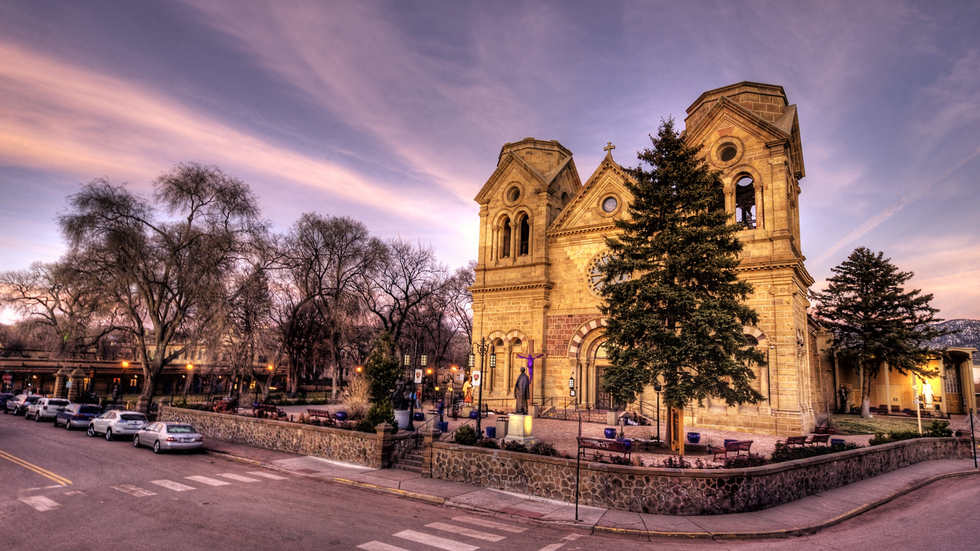
Dominating the Santa Fe skyline near the historic Plaza, the Cathedral Basilica of St. Francis of Assisi stands as a testament to faith and history, built on grounds consecrated for worship since the city's founding. The site's story began in 1610 with Santa Fe's first parish church. A larger adobe church replaced it around 1630, only to be destroyed during the Pueblo Revolt of 1680. After the Spanish return, a new adobe church, known as La Parroquia, was constructed between 1714 and 1717.
This modest adobe structure served the community for over 150 years until the arrival of Santa Fe's first Archbishop, Jean-Baptiste Lamy, in 1850. Finding La Parroquia inadequate for the growing Archdiocese, the French-born Lamy envisioned a grander cathedral reminiscent of those in his European homeland. In 1869, he commissioned French architects and Italian stonemasons to begin construction on the magnificent Romanesque Revival structure we see today. Built ambitiously around the existing La Parroquia, the new stone walls rose, and once they were complete, the old adobe church was carefully dismantled and removed through the front doors.
Using yellow limestone quarried near the present-day village of Lamy, the Cathedral took shape with characteristic round arches, a large rose window, and imposing twin towers. Though largely completed by 1886, the planned soaring spires for the towers were never added due to funding shortages. In recognition of its historical and religious importance, Pope Benedict XVI elevated the Cathedral to the status of Basilica in 2005.
Why It's a Must-See
The Cathedral Basilica is a cornerstone of any visit to Santa Fe. Its commanding Romanesque architecture offers a stunning visual contrast to the city's prevalent Pueblo Revival style, embodying Archbishop Lamy's ambitious vision and representing a distinct chapter in Santa Fe's architectural evolution.
Beyond its impressive facade, the Cathedral is deeply woven into the historical fabric of Santa Fe. Standing on a site of worship dating back over 400 years, it connects visitors to the eras of Spanish colonization, the pivotal Pueblo Revolt, and the development of New Mexico under leaders like Lamy.
Inside, the Cathedral unfolds with artistic and spiritual beauty. Magnificent stained-glass windows, imported from France, depict the twelve apostles and bathe the nave in colored light. The massive bronze front doors recount scenes from the Archdiocese's history, while the intricately carved altar screen (reredos) and numerous sacred artworks inspire awe. It remains the active mother church of the Archdiocese, a place of pilgrimage, prayer, and home to one of the nation's most significant religious icons, La Conquistadora.
5 Things Most People Don't Know About the Cathedral Basilica
-
It Contains Part of an Older Adobe Church: The northernmost chapel, dedicated to La Conquistadora, is not part of the main stone structure. It's a preserved section of the earlier adobe church, La Parroquia, dating back to the early 1700s.
-
The Towers Remain Unfinished: The iconic twin towers look complete, but the original design called for much taller, elegant spires atop each one. Financial constraints halted construction before the spires could be realized.
-
Hebrew Name for God is Carved Above the Entrance: Look closely at the keystone in the main archway over the front doors. You'll see the Tetragrammaton (YHWH) – the sacred Hebrew name for God – inscribed within a triangle, a unique feature possibly included by Lamy to acknowledge support from local Jewish merchants or as a symbol of God's universality.
-
Home to the Oldest Statue of Mary in the U.S.: Housed within the historic adobe chapel is "La Conquistadora" (also known as Our Lady of Peace). This cherished wooden statue of the Virgin Mary was brought from Spain to Santa Fe in 1625, making her the oldest such image in the United States.
-
Archbishop Lamy is Buried Below the High Altar: Fittingly, the driving force behind the Cathedral's construction, Archbishop Jean-Baptiste Lamy, rests eternally in the crypt located directly beneath the main altar. Several subsequent archbishops are also interred there.


Add comment
Comments